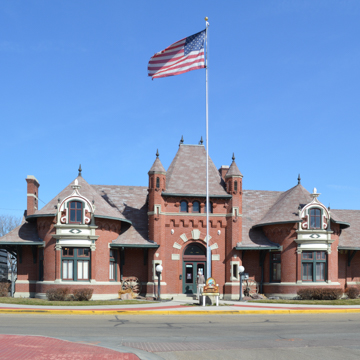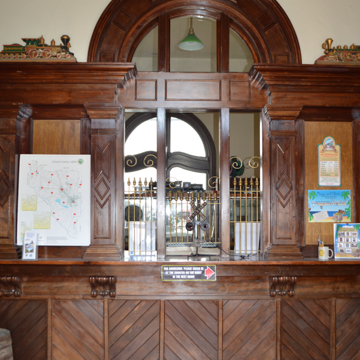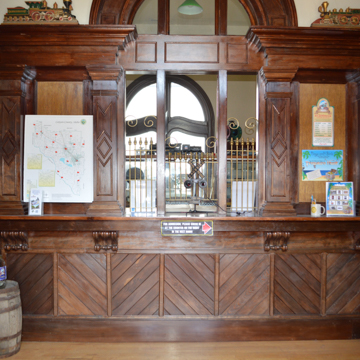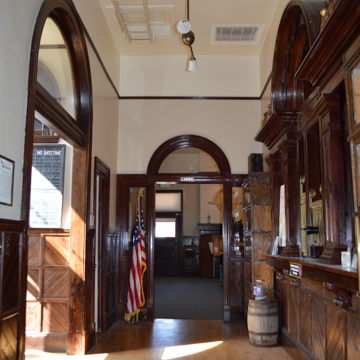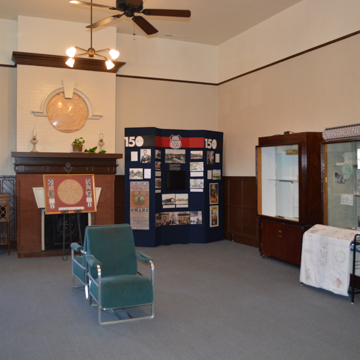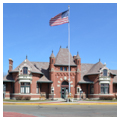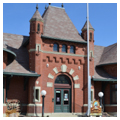You are here
Nampa Train Depot Museum
The Nampa Train Depot Museum was originally constructed as a depot for the Oregon Short Line, a subsidiary of the Union Pacific Railroad. The former depot is emblematic of the historic role that the railroads played in Nampa. During the height of the railroad era, Nampa was the nexus of four different railroad lines, each running in a cardinal direction and linking southwestern Idaho to the coasts and the territorial capital in Boise, to mining sites and shipping points, and to agricultural and ranching regions marketplaces.
A classic railroad town, Nampa was initially platted in 1885 by Alexander Dufuss. Consistent with successful railroad towns across the Intermountain West, Dufuss adopted a proven “T-Town” configuration; the main commercial street, historically known as G Street but later renamed Twelfth Street, runs perpendicular to the railroad tracks, bisecting a gridded network of streets and terminating at the depot. Due to the increasing volume of rail traffic, Nampa was also known as “Junction City.”
In 1903, the Union Pacific charged Frederick W. Clarke, a company architect based in Omaha, Nebraska, to design a replacement for its original, short-lived wooden depot. The company specified that the new depot should be “the finest on the line” to herald its dominant role in Idaho’s transportation industry. Clarke succeeded in this regard: his eye-catching design for the Nampa depot features an eclectic blend of the period’s most picturesque styles including French Renaissance, Baroque, and Romanesque revivalism. The depot’s siting at the terminus of the town’s principal commercial street reinforces its central economic role while also showing the influence of Baroque planning. Clarke used a hierarchy of forms to frame a central focal point at the end of the vista. The central portion’s chateau-style massing, with steep mansard roof and columnar finials, is punctuated by a contrasting Romanesque arch rendered in light sandstone to clearly define the main entry doors. The adjoining wings, which expand the vista, are decidedly Baroque in their massing and ornamentation with projecting, round brick bays, defined with sandstone cornices and capped with ogee-arched dormer windows.
The care taken in construction of the 1903 depot by local contractors, C.J. Humphis and J.M. Bray Clark, coupled with the Union Pacific’s investment in quality architecture and materiality, suggested a shared vision of both permanence and the symbolic role that a railroad depot should play in a railroad town. But in a mere twenty years, the 1903 depot became obsolete when rail traffic in Nampa grew to such an extent that the depot couldn’t handle the traffic. In 1925 the Union Pacific constructed a new Sullivanesque depot across the tracks to handle increased loads and, arguably, to better reflect an updated, progressive architectural image. The 1903 depot was adapted for use as company offices and for freight storage. Declining rail use during the second half of the twentieth century led to the demolition of the 1925 depot, an architectural icon in its own right, while ownership of the 1903 depot was transferred to the Canyon County Historical Society in 1972, following suspension of Amtrak passenger service the previous year.
In 1976 to honor the nation’s bicentennial, the society raised funds to partially restore the depot’s exterior and to adapt the interior for use as an interpretive museum and office space. Restoration and fundraising efforts are ongoing. The picturesque depot celebrates Nampa’s history and provides a beloved community landmark. Its high profile location at the terminus of downtown Nampa’s principal commercial street demonstrates the pivotal role that the depot played in the community.
References
Cain, Larry. How They Lived and Played: Nampa, Idaho 1900–1925 or Life in a Small Western Town. Nampa, ID: Self-published manuscript, 2006.
Caine, Larry. Interview by Wendy R. McClure. Boise, ID, March 6, 2015.
Hart, Arthur, “Nampa Depot,” Canyon County, Idaho. National Register of Historic Places Registration Form, 1972. National Park Service, U.S. Department of Interior, Washington, DC.
Meredith, Neil J. Saints and Oddfellows: A Bicentennial Sampler of Idaho Architecture. Boise, ID: Boise Gallery of Art Association, 1976.
Waite, Thornton. Union Pacific Rails to the Mines: The Boise, Nampa & Owyhee Railway. Columbia, MO, and Idaho Falls, ID: Brueggenjohann/Reese, Inc. and Thorton Waite Publishers, 1999.
Writing Credits
If SAH Archipedia has been useful to you, please consider supporting it.
SAH Archipedia tells the story of the United States through its buildings, landscapes, and cities. This freely available resource empowers the public with authoritative knowledge that deepens their understanding and appreciation of the built environment. But the Society of Architectural Historians, which created SAH Archipedia with University of Virginia Press, needs your support to maintain the high-caliber research, writing, photography, cartography, editing, design, and programming that make SAH Archipedia a trusted online resource available to all who value the history of place, heritage tourism, and learning.

